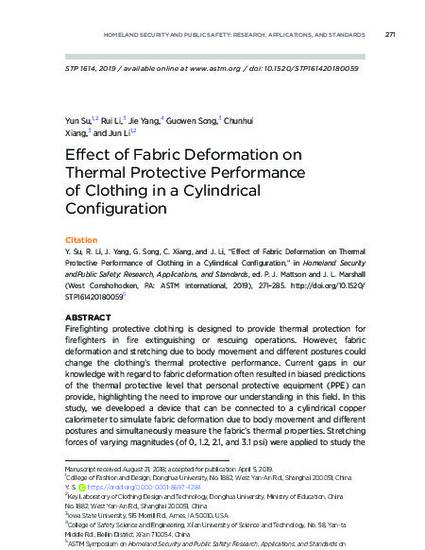
Firefighting protective clothing is designed to provide thermal protection for firefighters in fire extinguishing or rescuing operations. However, fabric deformation and stretching due to body movement and different postures could change the clothing's thermal protective performance. Current gaps in our knowledge with regard to fabric deformation often resulted in biased predictions of the thermal protective level that personal protective equipment (PPE) can provide, highlighting the need to improve our understanding in this field. In this study, we developed a device that can be connected to a cylindrical copper calorimeter to simulate fabric deformation due to body movement and different postures and simultaneously measure the fabric's thermal properties. Stretching forces of varying magnitudes (of 0, 1.2, 2.1, and 3.1 psi) were applied to study the effect of fabric deformation on the thermal protective performance of clothing under low- and high-intensity heat exposures. In addition, we analyzed skin burn times with different stretching forces and fabric properties. The selected fabrics were stretched by approximately 15 % under a stretching force of 3.1 psi. Fabric deformation led to a significant reduction of the predicted thermal protective performance of fabrics, mainly due to changes in fabric thickness, porosity, and mass per unit area. Predicted skin burn times decreased for increasing stretching forces, although the decrease was less pronounced under high-intensity heat exposure as a result of fabric shrinkage and degradation. The findings from this study further advance our current understanding of the thermal protective performance of clothing and may lead to the development of a new test to characterize clothing performance under more realistic usage situations.
Available at: http://works.bepress.com/guowen-song/18/

This book chapter is published as Y. Su, R. Li, J. Yang, G. Song, C. Xiang, and J. Li, “Effect of Fabric Deformation on Thermal Protective Performance of Clothing in a Cylindrical Configuration,” in Homeland Security andPublic Safety: Research, Applications, and Standards, ed. P. J. Mattson and J. L. Marshall (West Conshohocken, PA: ASTM International, 2019), 271–285. Doi: 10.1520/ STP1614201800595